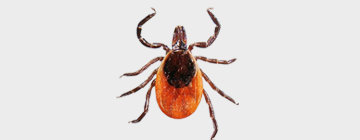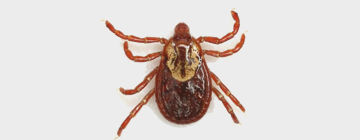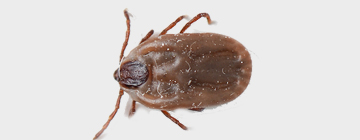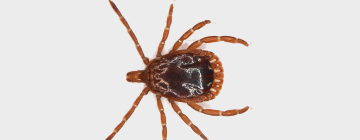INfomation about
Ticks
A small
Intro about Ticks
Ticks can be difficult for residential and commercial properties to control in NYC & NJ. Having a professional pest control company that specializes in serving New York and New Jersey is essential to a long term Ticks control solution that provides peace of mind.
Blacklegged Deer Ticks
Ixodes scapularis
Overview:
A notorious biting insect, the blacklegged tick is named for its dark legs, which are a contrast to its pale body. Blacklegged ticks are sometimes called deer ticks.
Habits:
Blacklegged deer ticks climb grass and shrubs to wait for a passing host. Adult ticks feed primarily on the white-tailed deer during the winter. In the spring, the female drops off the host and deposits about 3,000 eggs. Nymphs feed on mice, squirrels, raccoons, skunks, dogs, humans and birds.
Threats:
Blacklegged deer ticks are a vector of Lyme disease, anaplasmosis and babesiosis. Lyme disease is of primary concern in the United States. Symptoms include fever, headache, fatigue and a characteristic bull’s eye shaped skin rash. Lyme disease can also affect joints, the heart and the nervous system if left untreated.
Prevention:
- Wear light-colored long pants, long-sleeve shirts and closedtoe shoes when in wooded areas or tall grasses.
- Wear bug spray containing at least 20% DEETwhen outdoors.
- When hiking, stay in the center of trails, away from vegetation.
- Inspect yourself carefully for ticks after being outdoors. If you find a tick, remove it with a slow, steady pull.
- Inspect your pets for ticks on a routine basis.
- Consult with your doctor immediately if you believe you have contracted Lyme disease.
- If you find ticks in your home or on your property, contact a licensed pest professional.
Did you know? Blacklegged deer ticks…
- do not jump or fly, but can drop from their perch and fall onto a host. Some species of ticks actually follow a host by foot until they can climb aboard.
- can live as long as 200 days without food or water.


Color:
Orange-brown with dark legs
Shape:
Flat, broad oval
Size:
⁄1⁄₈ inch long
Region:
Found primarily in the northeastern, mid-Atlantic, southeastern and north central regions of the U.S.Packages For Ticks Protection
Save Money Today
up to $75 OFF
If you are a new customer, enjoy $75.00 off your Home Pest Protection Premium plan.
Coupon Code: HomePre22

Call & Get Your Free Estimate
855-737-8765
American Dog Ticks
Dermacentor variabilis
Overview:
Also known as the wood tick, the American dog tick gets its name from the fact that adult ticks prefer to feed on domestic dogs, coupled with the tick species being found only in North America. The American dog tick is a member of the hard tick family, meaning that it possesses a hard exterior shield. American dog ticks are known to harbor bacteria responsible for causing diseases in humans such as Rocky Mountain spotted fever, which is spread when they suck blood from their host. Exposure to these ticks is most likely to occur during spring and early summer.
Habits:
It is thought that American dog ticks are attracted by the scent of animals, so they are common along roads and trails. They also prefer grassy areas with low vegetation where larger mammals pass by. These pests thrive in areas where grasses, bushes and plants are accessible to humans. While American dog ticks choose habitats that maximize their exposure to potential hosts, they can survive for about 2-3 years (1,053 days) unfed. Adult American dog ticks prefer to bite domestic dogs and can therefore be brought into the home and potentially transferred to humans.
Threats:
The American dog tick is the primary vector of Rocky Mountain spotted fever (RMSF), which is caused by the bacterium Rickettsia rickettsia. According to the CDC, Rocky Mountain spotted fever has been a nationally recognized condition since the 1920s. Symptoms of Rocky Mountain spotted fever include high fever, chills, muscle aches and headaches. A rash that may spread across the extremities occurs in some cases. It usually develops 2-4 days after the fever begins. The disease is treated with antibiotics, but can be fatal if left untreated.
Prevention:
American dog tick bites can cause itching, fever and, in some cases, tick paralysis. Be on the look out for the development of rashes near the tick bite, as this is the primary symptom of tularemia and Rocky Mountain spotted fever. Ticks are not able to feed immediately after latching on to a host, as their mouthparts require several hours to imbed deeply enough to feed. This makes it very important to promptly remove a tick from the skin at first sight.
Did you know? American Dog Ticks
Oval and flattened in shape, American dog ticks are brown with whitish to gray markings. As larvae, they have six legs while nymphs and adults have eight. These extremities allow them to effectively crawl through their environment, as well as animal fur and human hair. Depending on whether or not they have fed on host blood, American dog ticks can range in size from 5 mm to 15 mm.
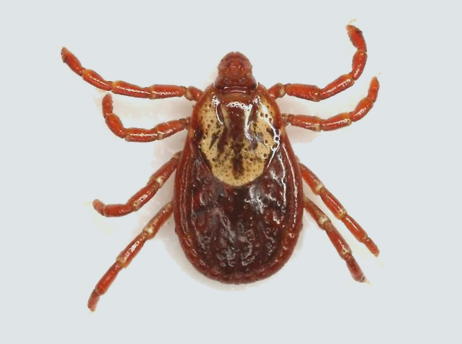

Color:
Brown with whitish to gray markings
Shape:
Oval, flattened
Size:
3/16” (5 mm) unengorged,5/8” (15 mm) engorged

Region:
Found throughout the U.S., except the Rocky Mountains areaCall & Get Your Free Estimate
855-737-8765 or
Brown Dog Ticks
Rhipicephalus sanguineus
Overview:
The Brown Dog tick gets its common name from its overall reddish brown color, and because it is commonly found on domestic dogs. Although this species is most commonly encountered indoors and in kennels, it typically does not bite humans. However, it will do so in the absence of a canine host on rare occasions. If found on a dog or other animal, the brown dog tick should be removed as soon as possible. This tick is found throughout the United States and the world, typically in warmer climates. Keep reading if you want to learn more about brown dog ticks, including treatment and removal of ticks.
Habits:
On dogs, adult brown dog ticks can typically be found on the ears and between the toes, while younger or immature ones attach along the dog’s back. Knowing proper dog tick removal is essential. When not feeding on a host, brown dog ticks can be found both outside and inside, although they generally prefer the warm, dry conditions inside homes. Brown dog ticks are unusual among ticks in that they can complete their entire life cycle indoors, allowing them to establish populations in colder climates. Outdoors, they’re known to scale up shrubs, grass and other vegetation, attaching themselves to passing hosts such as dogs, deer, rabbits and even humans.
Threats:
Although dogs are the preferred host, brown dog ticks will feed on other mammals (including domestic animals and humans) if dogs are not available. They rarely feed on humans, but brown dog ticks can serve as vectors of Rocky Mountain spotted fever (RMSF), which is caused by the rickettsial bacterium Rickettsia rickettsii, and Boutonneuse fever which is caused by the rickettsial bacterium Rickettsia conorii. Additionally, they can transmit several tick-borne diseases to dogs, including canine ehrlichiosis and canine Babesia, which can cause symptoms including fever, bleeding disorders and systemic shock.
Prevention:
The best way to prevent brown dog ticks is awareness of dog surroundings and dog prevention medications. Keeping pet areas clean and free of debris can help locate engorged ticks looking to lay eggs and remove them from the house. Brown dog tick treatment for pets is also an important prevention tool. Pets should be treated with flea and tick repellent as necessary.
Did you know? Brown Dog Ticks
Unengorged, adult brown dog ticks are about 1/8″ long, but enlarge up to about 1/2″ long when engorged with blood. Both male and female dog ticks have flat, reddish brown, oval bodies, but when engorged may become gray-blue or olive color. Male dog ticks have tiny pits scattered over the back. Their scutum (shield) is present, and covers their entire back, while female scutum only covers the front part of a female’s back. In both male and female dog ticks, the eyes are on margin of the scutum, with mouthparts visible from above.


Color:
Reddish brown, gray-blue when engorged
Shape:
Oval, flattened
Size:
1/8” (3 mm) unengorged;1/2” (12 mm) engorged

Region:
Found throughout the U.S.Packages For Ticks Protection
Save Money Today
up to $25 OFF
If you are a new customer, enjoy $75.00 off your Home Pest Protection Premium plan.
Coupon Code: HomePre22
Call & Get Your Free Estimate
855-737-8765
Lone Star Ticks
Amblyomma americanum (Linnaeus)
Overview:
The lone star tick gets its name from the single silvery-white spot located on the female’s back. These ticks attack humans more frequently than any other tick species in the eastern and southeastern states. Lone star tick bites will occasionally result in a circular rash, and they can transmit diseases. It is essential that lone star tick removal start immediately.
Habits:
The lone star tick is a 3-host tick, with each stage requiring a different host. These ticks usually contact a host by crawling up on the tips of low-growing vegetation and waiting for a host to pass by and brush the vegetation. While larvae are almost entirely dependent on this behavior, nymphs and adults may become stimulated by the warmth and carbon dioxide from a host spending considerable time in the area and will drop to the ground, find the host, and climb onto it.
Threats:
The lone start tick is known to bite humans. This tick is a vector of many dangerous diseases, including tularemia, Heartland virus, Bourbon virus and Southern tick-associated rash illness (STARI). Great care should be exercised when removing embedded ticks because their long mouthparts make removal difficult. The mouthparts are often broken off during removal which may result in secondary infection.
Prevention:
Habitat modification and the removal of hosts are key to lone star tick removal. Keep grass cut low, and trim back vegetation along trails, paths, and yard edges. Remove debris and ground cover to discourage rodents from making the yard their home. If you suspect a lone start tick problem on your property, contact a licensed pest control professional.
Did you know? Lone Star Ticks
Unengorged adult female lone star ticks are about 1/8 inches long, while males are slightly smaller. When engorged, adult female lone star ticks can be up to 7/16 inches long. Lone star ticks have reddish brown oval bodies that become slate grey when engorged. Females have a single whitish to silvery spot on their backs, whereas make lone star ticks have several inverted horseshoe-shaped whitish spots along their backs.
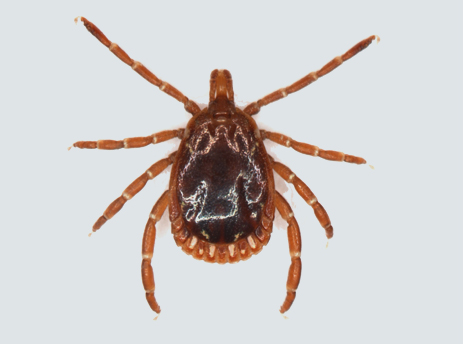

Color:
Reddish brown, becoming slate gray when engorged
Shape:
Oval, flattened
Size:
Females are 1/6-1/4” (4-6 mm) un-engorged and 1/2” (16 mm) engorged; Males are smaller


